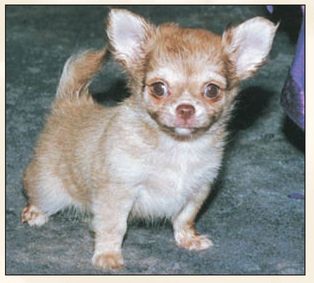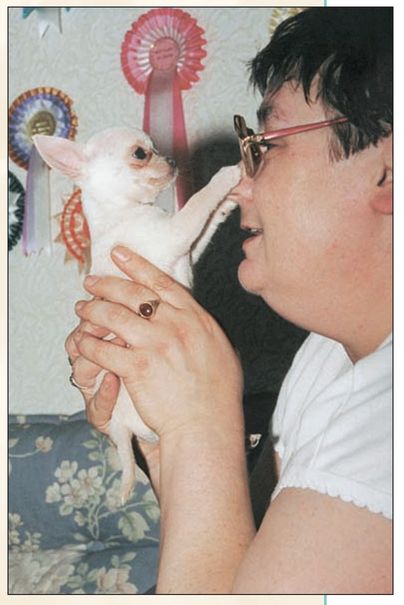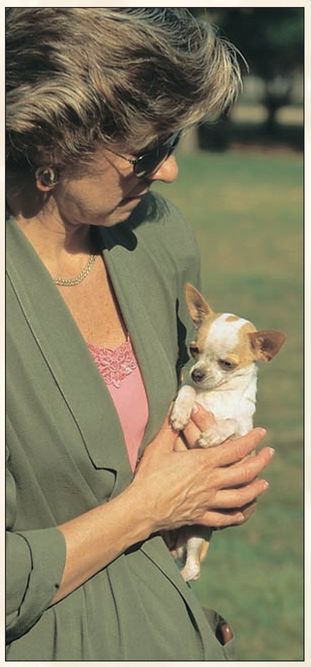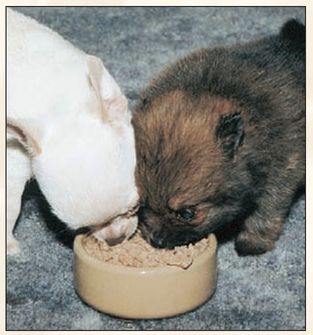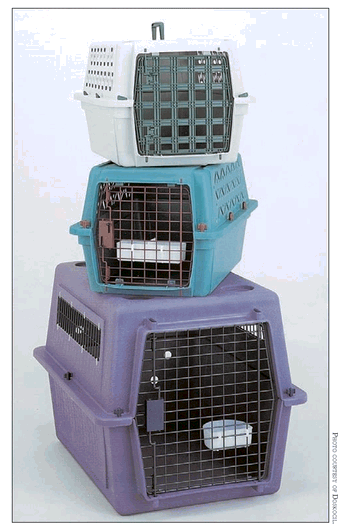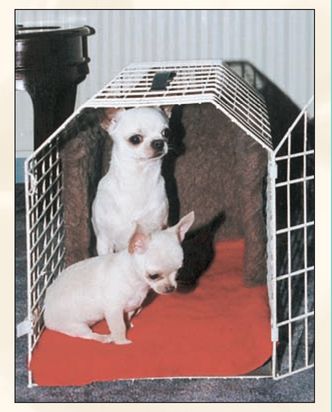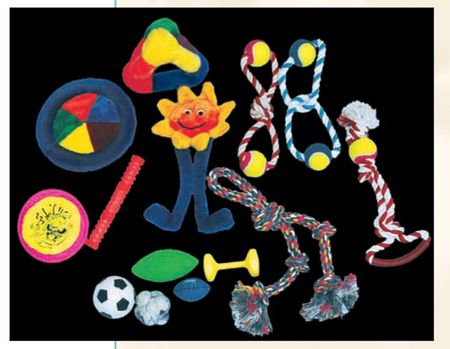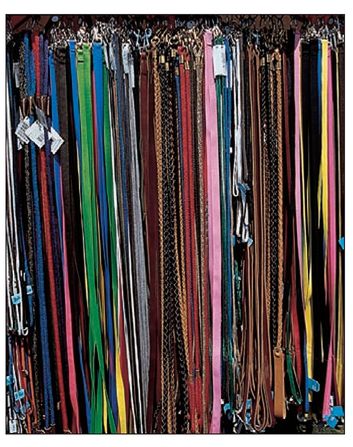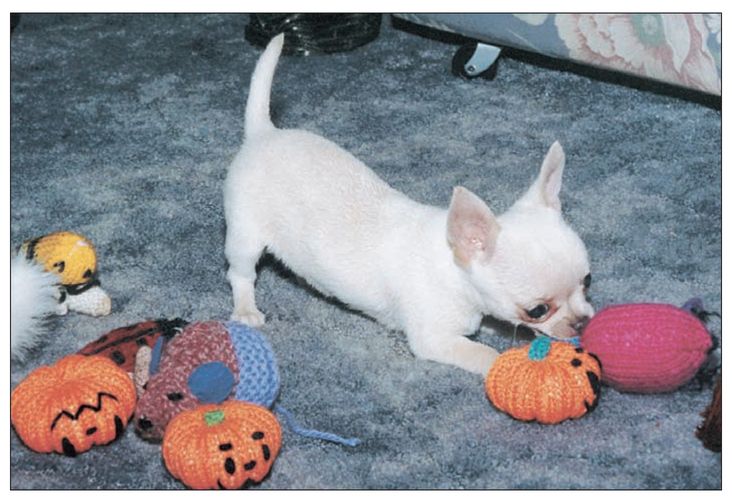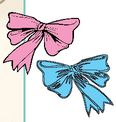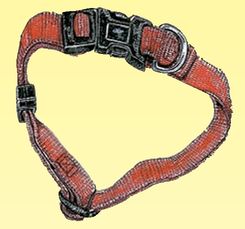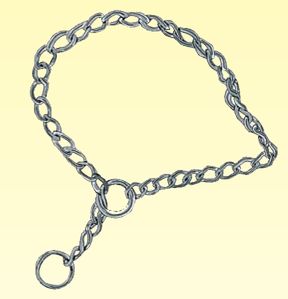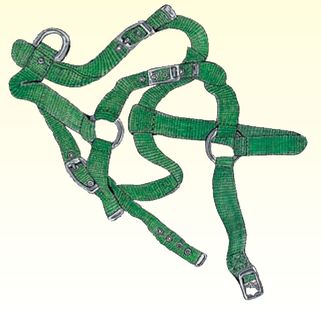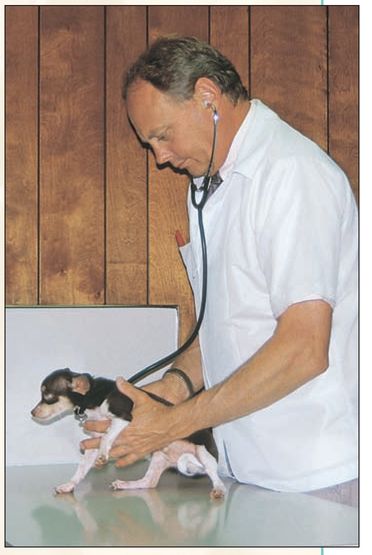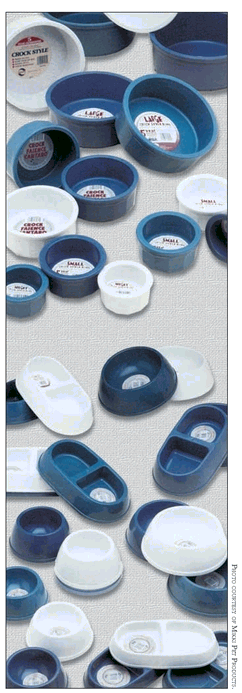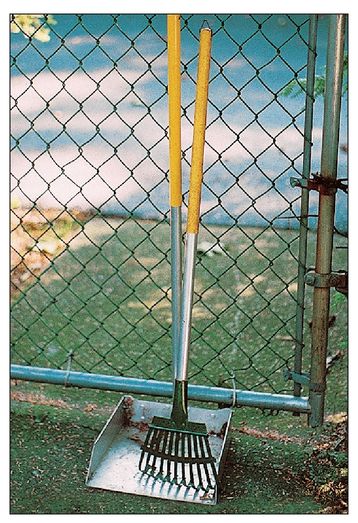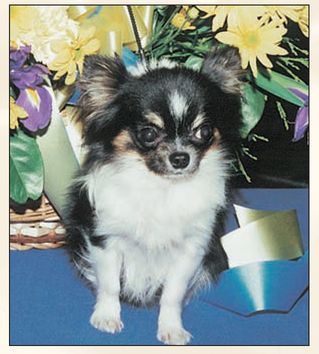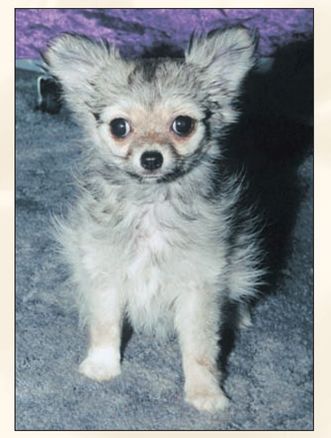YOUR PUPPY
CHIHUAHUA
Chihuahuas are not for everyone! That same statement applies to most breeds of dog as well as to dogs in general, but breeders feel especially strong about not selling Chihuahua puppies to just any interested buyer. Mr. Graham Foote says, “As a breeder I think that my Chihuahuas are not suitable pets for all homes. Initial inquiries generally come in by phone and I want to know as much as possible about the prospective owner before I let them come to see the puppies. I want to know if they have had a Chihuahua before, what happened to it, have they had other dogs before (or presently), do they have children, etc. I will not normally let my pups go to homes with girls under the age of eight years or boys under the age of twelve. Some breeders will not sell their dogs to elderly people but my experience has been that dogs and elderly people can be great companions for each other and I have never refused someone because of age. I do, however, always discuss the situation with prospective owners and tactfully say that
Chihuahuas can live a very long time, and while I hope they outlive their new pet, they must consider written arrangements for the care of the dog should they no longer be able to care for it.”
“When I sell a Chihuahua, I always advise the new owners that the dog should not be excessively mollycoddled and to treat them as they would a larger dog. Our Chihuahuas run out in the snow, frost, rain and as long as they are running about there is no problem. Being so small, Chihuahuas can lose body heat quite rapidly and must not be left sitting out in the cold.”
WHERE TO BEGIN?
If you are convinced that the Chihuahua is the ideal dog for you, it’s time to learn about where to find a puppy and what to look for. Locating a litter of Chihuahuas should not present a problem for the new owner, as the breed is one of the more popular toy breeds in the world. You should inquire about breeders in your area who enjoy a good reputation in the breed. You are looking for an established breeder with outstanding dog ethics and a strong commitment to the breed. New owners should have as many questions as they have doubts. An established breeder is indeed the one to answer your four million questions and make you comfortable with your choice of the Chihuahua. An established breeder will sell you a puppy at a fair price if, and only if, the breeder determines that you are a suitable, worthy owner of his/her dogs. An established breeder can be relied upon for advice, no matter what time of day or night. A reputable breeder will accept a puppy back, without questions, should you decide that this is not the right dog for you.
ARE YOU PREPARED?
Unfortunately, when a puppy is bought by someone who does not take into consideration the time and attention that dog ownership requires, it is the puppy who suffers when he is either abandoned or placed in a shelter by a frustrated owner. So all of the “homework” you do in preparation for your pup’s arrival will benefit you both. The more informed you are, the more you will know what to expect and the better equipped you will be to handle the ups and downs of raising a puppy. Hopefully, everyone in the household is willing to do his part in raising and caring for the pup. The anticipation of owning a dog often brings a lot of promises from excited family members: “I will walk him every day,” “I will feed him,” “I will house-train him,” etc., but these things take time and effort, and promises can easily be forgotten once the novelty of the new pet has worn off.
When choosing a breeder, reputation is much more important than convenience of location. Do not be overly impressed by breeders who run brag advertisements in the dog magazines about their stupendous champions. The real quality breeders are quiet and unassuming. You hear about them at the dog shows, by word of mouth.
It’s recommended that you acquire a Chihuahua that is around ten to twelve weeks of age. Socialization is a breeder concern of considerable importance. Puppies that remain with their breeder for a few months may exhibit a lack of social graces and may not bond with a new owner as readily as the younger puppy.
Choosing a breeder is an important first step in dog ownership. Fortunately, the majority of Chihuahua breeders is devoted to the breed and its well-being. New owners should have little problem finding a reputable breeder who doesn’t live in another state or on the other side of the country. The American Kennel Club is able to refer you to breeders of quality Chihuahuas, as can any local all-breed club or Chihuahua club. Potential owners are encouraged to attend dog shows to see the Chihuahuas strutting around the ring, to meet the owners and handlers firsthand and to get an idea of what Chihuahuas look like outside a photographer’s lens. Provided you approach the handlers when they are not terribly busy with the dogs, most are more than willing to answer questions, recommend breeders and give advice.
Once you have contacted and met a breeder or two and made your choice about which breeder is best suited to your needs, it’s time to visit the litter. Keep in mind that most top breeders have waiting lists, and given the small size of Chihuahua litters (one to four pups), these can be most disheartening. Sometimes new owners have to wait as long as two to three years for a puppy. If you are very anxious (and truly prepared), you may have to resort to your second- or third-choice breeder. Use common sense. If the breeder doesn’t have a waiting list, or any customers, there is probably a good reason. It’s no different than visiting a restaurant with no clientele. The better restaurants always have a waiting list—and it’s usually worth the wait. Besides, isn’t a puppy more important than a great meal?
TEMPERAMENT COUNTS
Your selection of a good puppy can be determined by your needs. A show potential or a good pet? It is your choice. Every puppy, however, should be of good temperament. Although show-quality puppies are bred and raised with emphasis on physical conformation, responsible breeders strive for equally good temperament. Do not buy from a breeder who concentrates solely on physical beauty at the expense of personality.
INHERIT THE MIND
In order to know whether or not a puppy will fit into your lifestyle, you need to assess his personality. A good way to do this is to interact with his parents. Your pup inherits not only his appearance but also his personality and temperament from his sire and dam. If the parents are fearful or overly aggressive, these same traits may show up in your puppy.
Since you are likely to be choosing a Chihuahua as a pet dog and not a show dog, you simply should select a pup that is friendly and attractive. The gender of your puppy is largely a matter of personal taste, as is coloration. As the many photographs in this book evidence, the breed comes in a multitude of lovely colors. The coat length of your Chihuahua is a more important consideration as the Longhair will require more grooming than the Smooth, though neither is very time-consuming.
Breeders commonly allow visitors to see the litter by around the fifth or sixth week, and puppies leave for their new homes between the tenth and twelfth week. Given the tiny size of the breed, and the dainty limbs and molera on the skull, breeders simply cannot afford to risk allowing new owners to adopt their new charges too early.
PUPPY APPEARANCE
Your puppy should have a well-fed appearance but not a distended abdomen, which may indicate worms or incorrect feeding, or both. The body should be firm, with a solid feel. The skin of the abdomen should be pale pink and clean, without signs of scratching or rash. Check the hind legs to make certain that dewclaws were removed, if any were present at birth.
COMMITMENT OF OWNERSHIP
After considering all of these factors, you have most likely already made some very important decisions about selecting your puppy. You have chosen a Chihuahua, which means that you have decided which characteristics you want in a dog and what type of dog will best fit into your family and lifestyle. If you have selected a breeder, you have gone a step further—you have done your research and found a responsible, conscientious person who breeds quality Chihuahuas and who should be a reliable source of help as you and your puppy adjust to life together.
Visiting a litter will assist you in learning to recognize what a healthy pup should look like and how pups interact and behave. A well-socialized Chihuahua will be anxious to meet new humans and will welcome an extended friendly hand and a warm lap.
Researching your breed, selecting a responsible breeder and observing a litter are all important steps on the way to dog ownership. It may seem like a lot of effort…and you have not even brought the pup home yet! Remember, though, you cannot be too careful when it comes to deciding on the type of dog you want and finding out about your prospective pup’s background. Buying a puppy is not—or should not be—just another whimsical purchase. This is one instance in which you actually do get to choose your own family! You may be thinking that buying a puppy should be fun—it should not be so serious and so much work. Keep in mind that your puppy is not a cuddly stuffed toy or decorative ornament, but a creature that will become a real member of your family. You will come to realize that, while buying a puppy is a pleasurable and exciting endeavor, it is not something to be taken lightly. Relax…the fun will start when the pup comes home!
These Chihuahua babies are too young to receive visitors. Breeders commonly allow visitors around the fifth or sixth week.
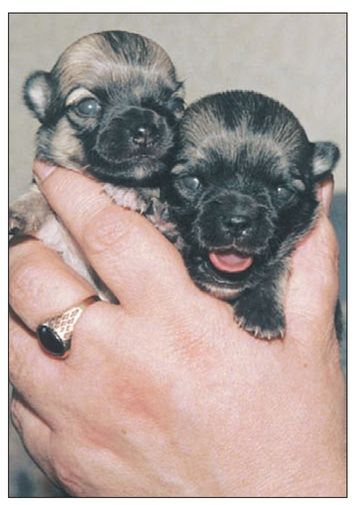
PUPPY’S PAPERS
Too often new owners are confused between two important documents, the pedigree and the registration certificate. Your puppy’s pedigree, essentially a family tree, is a written record of a dog’s genealogy of three generations or more. The pedigree will show you the names as well as performance titles of all dogs in your pup’s background (Ch., CD, CGC, etc.). Your breeder must provide you with a registration application, with his part properly filled out. You must complete the application and send it to the American Kennel Club (AKC) with the proper fee. The seller must provide you with complete records to identify the puppy. The AKC requires that the seller provide the buyer with the following: breed; sex, color and markings; date of birth; litter number (when available); names and registration numbers of the parents; breeder’s name; and date sold or delivered.
Always keep in mind that a puppy is nothing more than a baby in a furry disguise…a baby who is virtually helpless in a human world and who trusts his owner for fulfillment of his basic needs for survival. In addition to food, water and shelter, your pup needs care, protection, guidance and love. If you are not prepared to commit to this, then you are not prepared to own a dog, particularly a Chihuahua who lives for the love of his master or mistress.
PREPARING PUPPY’S PLACE IN YOUR HOME
Researching your breed and finding a breeder are only two aspects of the “homework” you will have to do before taking your Chihuahua puppy home. You will also have to prepare your home and family for the new addition. Much as you would prepare a nursery for a newborn baby, you will need to designate a place in your home that will be the puppy’s own. How you prepare your home will depend on how much freedom the dog will be allowed. Whatever you decide, you must ensure that he has a place that he can “call his own.”
When you bring your new puppy into your home, you are bringing him into what will become his home as well. Obviously, you did not buy a puppy so that he could take control of your house, but in order for a puppy to grow into a stable, well-adjusted dog, he has to feel comfortable in his surroundings. Remember, he is leaving the warmth and security of his mother and littermates, as well as the familiarity of the only place he has ever known, so it is important to make his transition as easy as possible. By preparing a place in your home for the puppy, you are making him feel as welcome as possible in a strange new place. It should not take him long to get used to it, but the sudden shock of being transplanted is somewhat traumatic for a young pup. Imagine how a small child would feel in the same situation—that is how your puppy must be feeling. It is up to you to reassure him and to let him know, “Little amigo, you are going to like it here!”
WHAT YOU SHOULD BUY
CRATE
To someone unfamiliar with the use of crates in dog training, it may seem like punishment to shut a dog in a crate, but this is not the case at all. Most experi enced breeders and trainers recommend crates as preferred tools for show puppies as well as pet puppies. Some breeders will only sell you a pup on the condition that you crate-train it.
QUALITY FOOD
The cost of food must be mentioned. All dogs need a good-quality food with an adequate supply of protein to develop their bones and muscles properly. Most dogs are not picky eaters but, unless fed properly, can quickly succumb to skin problems.
Crates are not cruel—crates have many humane and highly effective uses in dog care and training. For example, crate training is a very popular and very successful housebreaking method. A crate can keep your dog safe during travel; and, perhaps most importantly, a crate provides your dog with a place of his own in your home. It serves as a “doggie bedroom” of sorts—your Chihuahua can curl up in his crate when he wants to sleep or when he just needs a break. Many dogs sleep in their crates overnight. When lined with soft bedding and with some of his favorite toys, a crate becomes a cozy pseudo-den for your dog. Like his burrowing ancestors, he too will seek out the comfort and retreat of a den—you just happen to be providing him with something a little more luxurious than what his early ancestors enjoyed.
Your local pet shop probably has a large variety of crates from which you can choose the one that best suits your needs.
As far as purchasing a crate, the type that you buy is up to you. It will most likely be one of the two most popular types: wire or fiberglass. There are advantages and disadvantages to each type. For example, a wire crate is more open, allowing the air to flow through and affording the dog a view of what is going on around him, while a fiberglass crate is sturdier and less drafty. Both can double as travel crates, providing protection for the dog. A small crate will be sufficient to accommodate your Chihuahua.
INSURANCE
Just like you can insure your car, your house and your own health, you likewise can insure your dog’s health. Investigate a pet insurance policy by talking to your vet. Depending on the age of your dog, the breed and the kind of coverage you desire, your policy can be very affordable. Most policies cover accidental injuries, poisoning and thousands of medical problems and illnesses. Some carriers also offer routine care and immunization coverage, including spaying/ neutering, health screening and more.
BEDDING
A soft mat in the dog’s crate will help the dog feel more at home and you may also like to throw in a small blanket. This will take the place of the leaves, twigs, etc., that the pup would use in the wild to make a den; the pup can make his own burrow in the crate. Although your pup is far removed from his den-making ancestors, the denning instinct is still a part of his genetic makeup. Second, until you bring your pup home, he has been sleeping amid the warmth of his mother and littermates, and while a blanket is not the same as a warm, breathing body, it still provides heat and something with which to snuggle. You will want to wash your pup’s bedding frequently in case he has an accident in his crate, and replace or remove any blanket that becomes ragged and starts to fall apart.
TOYS
Toys are a must for dogs of all ages, especially for curious playful pups. Puppies are the “children” of the dog world, and what child does not love toys? Chew toys provide enjoyment to both dog and owner—your dog will enjoy playing with his favorite toys, while you will enjoy the fact that they distract him from your expensive shoes and leather couch. Puppies love to chew; in fact, chewing is a physical need for pups as they are teething, and everything looks appetizing! The full range of your possessions—from old dish towel to Oriental carpet—are fair game in the eyes of a teething pup. Puppies are not all that discerning when it comes to finding something to literally “sink their teeth into”—everything tastes great!
CRATE-TRAINING TIPS
Chihuahuas take to crates quite naturally and usually welcome the security and privacy that the crate provides. During crate training, you should partition off the section of the crate in which the pup stays. If he is given too big an area, this will hinder your training efforts. Crate training is based on the fact that a dog does not like to soil his sleeping quarters, so it is ineffective to keep a pup in a crate that is so big that he can eliminate in one end and get far enough away from it to sleep.
Also, you want to make the crate den-like for the pup. Blankets and a favorite toy will make the crate cozy for the small pup. It will take some coaxing at first, but be patient. Given some time to get used to it, your pup will adapt to his new home-within-a-home quite nicely.
TOYS , TOYS , TOYS !
With a big variety of dog toys available, and so many that look like they would be a lot of fun for a dog, be careful in your selection. It is amazing what a set of puppy teeth can do to an innocent-looking toy; so, obviously, safety is a major consideration. Be sure to choose the most durable products that you can find. Hard nylon bones and toys are a safe bet, and many of them are offered in different scents and flavors that will be sure to capture your dog’s attention. It is always fun to play a game of fetch with your dog, and there are balls and flying discs that are specially made to withstand the wear-and-tear of dog teeth.
Be careful of natural bones, which have a tendency to splinter into sharp, dangerous pieces. Also be careful of rawhide, which can turn into pieces that are easy to swallow and become a mushy mess on your carpet.
LEASH
A nylon leash is probably the best option as it is the most resistant to puppy teeth should your pup take a liking to chewing on his leash. Of course, this is a habit that should be nipped in the bud but, if your pup likes to chew on his leash, he has a very slim chance of being able to chew through the strong nylon. Nylon leashes are also lightweight, which is good for a Chihuahua who is just getting used to the idea of walking on a leash. For everyday walking and safety purposes, the nylon leash is a good choice. As your pup grows up and gets used to walking on the leash, you may want to purchase a flexible leash. These leashes allow you to extend the length to give the dog a broader area to explore or to shorten the length to keep the dog closer to you. Of course, there are special show leads, and specially made halters or harnesses, which may be more comfortable for your Chihuahua.
COLLAR
Your pup should get used to wearing a collar all the time since you will want to attach his ID tags to it. Plus, you have to attach the leash to something! A lightweight nylon collar is a good choice; make sure that it fits snugly enough so that the pup cannot wriggle out of it, but is loose enough so that it will not be uncomfortably tight around the pup’s neck. You should be able to fit a finger between the pup and the collar. It may take some time for your pup to get used to wearing the collar, but soon he will not even notice that it is there.
FINANCIAL RESPONSIBILITY
Grooming tools, collars, leashes, a crate, a dog bed and, of course, toys will be expenses to you when you first obtain your pup, and the cost will continue throughout your dog’s lifetime. If your puppy damages or destroys your possessions (as most puppies surely will!) or something belonging to a neighbor, you can calculate additional expense. There is also flea and pest control, which every dog owner faces more than once. You must be able to handle the financial responsibility of owning a dog.
Your local pet shop should have a wide variety of leashes from which you can select the lightest type for your Chihuahua.
FOOD AND WATER BOWLS
Your pup will need two bowls, one for food and one for water. You may want two sets of bowls, one for inside and one for outside, though your Chihuahua will not spend too much time outdoors. Stainless steel or sturdy plastic bowls are popular choices. Plastic bowls are more chewable. Dogs tend not to chew on the steel variety, which can be sterilized. It is important to buy sturdy bowls since anything is in danger of being chewed by puppy teeth and you do not want your dog to be constantly chewing his bowl (for his safety and for your wallet!).
CLEANING SUPPLIES
Until a pup is house-trained, you will be doing a lot of cleaning. “Accidents” will occur, which is all right in the beginning because the puppy does not know any better. All you can do is be prepared to clean up any accidents. Old rags, towels, newspapers and a safe disinfectant are good to have on hand.
BEYOND THE BASICS
The items previously discussed are the bare necessities. You will find out what else you need as you go along—grooming supplies, flea/tick protection, baby gates to partition a room, etc. These things will vary depending on your situation, but it is important that you have everything you need to feed and make your Chihuahua comfortable in his first few days at home.
PUPPY-PROOFING YOUR HOME
Aside from making sure that your Chihuahua will be comfortable in your home, you also have to make sure that your home is safe for your Chihuahua. This means taking precautions that your pup will not get into anything he should not get into and that there is nothing within his reach that may harm him should he sniff it, chew it, inspect it, etc. This probably seems obvious since, while you are primarily concerned with your pup’s safety, at the same time you do not want your belongings to be ruined. Breakables should be placed out of reach if your dog is to have full run of the house. If he is to be limited to certain places within the house, keep any potentially dangerous items in the “off-limits” areas. An electrical cord can pose a danger should the puppy decide to taste it—and who is going to convince a pup that it would not make a great chew toy? Cords should be fastened tightly against the wall. If your dog is going to spend time in a crate, make sure that there is nothing near his crate that he can reach if he sticks his curious little nose or paws through the openings. Just as you would with a child, keep all household cleaners and chemicals where the pup cannot reach them.
All puppies, including Chihuahuas, love to chew on soft things. Offer only toys made for dogs, and monitor the condition of all of your ChiChi’s toys, as soft toys are easily destructible.
It is also important to make sure that the outside of your home is safe. Of course your puppy should never be unsupervised, but a pup let loose in the yard will want to run and explore, and he should be granted that freedom. Do not let a fence give you a false sense of security; you would be surprised how crafty (and persistent) a dog can be in working out how to dig under and squeeze his way through small holes, or to climb over a fence. Be sure to repair or secure any gaps in the fence. Check the fence periodically to ensure that it is in good
BOY OR GIRL?
An important consideration to be discussed is the sex of your puppy. For a family companion, a bitch may be the better choice, considering the female’s inbred concern for all young creatures and her accompanying tolerance and patience. It is always advisable to spay a pet bitch, which may guarantee her a longer life.
shape and make repairs as needed. A determined Chihuahua may return to the same spot to “work on it” until he is able to get through, and it doesn’t take a terribly large hole for the Chihuahua to escape.
FIRST TRIP TO THE VET
You have picked out your puppy, and your home and family are ready. Now all you have to do is collect your Chihuahua from the breeder and the fun begins, right? Well…not so fast. Something else you need to prepare is your pup’s first trip to the veterinarian. Perhaps the breeder can recommend someone in the area who specializes in Chihuahuas or toy breeds, or maybe you know some other Chihuahua owners who can suggest a good vet. Either way, you should have an appointment arranged for your pup before you pick him up and plan on taking him for an examination before bringing him home.
CHOOSE AN APPROPRIATE COLLAR
The BUCKLE COLLAR is the standard collar used for everyday purposes. Be sure that you adjust the buckle on growing puppies. Check it every day. It can become too tight overnight! These collars can be made of leather or nylon. Attach your dog’s identification tags to this collar.
The CHOKE COLLAR is constructed of highly polished steel so that it slides easily through the stainless steel loop. The idea is that the dog controls the pressure around its neck and he will stop pulling if the collar becomes uncomfortable. Choke collars should never be used on a toy dog like the Chihuahua.
The HALTER is for a trained dog that has to be restrained to prevent running away, chasing a cat and the like. Considered the most humane of all restraining devices, it is frequently used on smaller dogs for which collars are not comfortable.
The pup’s first visit will consist of an overall examination to make sure that the pup does not have any problems that are not apparent to you. The veterinarian will also set up a schedule for the pup’s vaccinations; the breeder will inform you of which ones the pup has already received and the vet can continue from there.
INTRODUCTION TO THE FAMILY
Everyone in the house will be excited about the puppy’s coming home and will want to pet him and play with him, but it is best to make the introduction low-key so as not to overwhelm the puppy. He is apprehensive already. It is the first time he has been separated from his mother and the breeder, and the ride to your home is likely to be the first time he has been in a car. The last thing you want to do is smother him, as this will only frighten him further. This is not to say that human contact is not extremely necessary at this stage, because this is the time when a connection between the pup and his human family is formed. Gentle petting and soothing words should help console him, as well as just putting him down and letting him explore on his own (under your watchful eye, of course).
HOW VACCINES WORK
If you’ve just bought a puppy, you surely know the importance of having your pup vaccinated, but do you understand how vaccines work?
Vaccines contain the same bacteria or viruses that cause the disease you want to prevent, but they have been chemically modified so that they don’t cause any harm. Instead, the vaccine causes your dog to produce antibodies that fight the harmful bacteria. Thus, if your pup is exposed to the disease in the future, the antibodies will destroy the viruses or bacteria. Discuss vaccinations with your veterinarian.
When purchasing bowls for your ChiChi, select small, shallow vessels. Your dog is going to eat and drink, not bathe in his bowl!
The pup may approach the family members or may busy himself with exploring for a while. Gradually, each person should spend some time with the pup, one at a time, crouching down to get as close to the pup’s level as possible and letting him sniff their hands and petting him gently. He definitely needs human attention and he needs to be touched—this is how to form an immediate bond. Just remember that the pup is experiencing a lot of things for the first time, at the same time. There are new people, new noises, new smells and new things to investigate, so be gentle, be affectionate and be as comforting as you can be.
YOUR PUP’S FIRST NIGHT HOME
You have traveled home with your new charge safely in his basket or crate. He’s been to the vet for a thorough check-up; he’s been weighed, his papers examined; perhaps he’s even been vaccinated and wormed as well. He’s met the family and he’s licked the whole family, including the excited children and the less-than-happy cat. He’s explored his area, his new bed, the yard and anywhere else he’s been permitted. He’s eaten his first meal at home and relieved himself in the proper place. He’s heard lots of new sounds, smelled new friends and seen more of the outside world than ever before.
That was just the first day! He’s worn out and is ready for bed…or so you think!
It’s puppy’s first night and you are ready to say “Good night”—keep in mind that this is puppy’s first night ever to be sleeping alone. His dam and littermates are no longer at paw’s length and he’s a bit scared, cold and lonely. Be reassuring to your new family member. This is not the time to spoil him and give in to his inevitable whining.
Puppies whine. They whine to let others know where they are and hopefully to get company out of it. Place your pup in his new bed or crate in his room and close the door. Mercifully, he may fall asleep without a peep. If the inevitable occurs, ignore the whining; he is fine. Be strong and keep his interest in mind. Do not allow yourself to feel guilty and visit the pup. He will fall asleep eventually.
Many breeders recommend placing a piece of bedding from his former home in his new bed so that he recognizes the scent of his littermates. Others still advise placing a hot water bottle in his bed for warmth. This latter may be a good idea provided the pup doesn’t attempt to suckle—he’ll get good and wet and may not fall asleep so fast.
Your local pet shop probably has tools that can make cleaning up more convenient.
Puppy’s first night can be somewhat stressful for the pup and his new family. Remember that you are setting the tone of nighttime at your house. Unless you want to play with your pup every evening at 10 p.m., midnight and 2 a.m., don’t initiate the habit. Your family will thank you, and so will your pup!
PREVENTING PUPPY PROBLEMS
SOCIALIZATION
Now that you have done all of the preparatory work and have helped your pup get accustomed to his new home and family, it is about time for you to have some fun! Socializing your Chihuahua pup gives you the opportunity to show off your new friend, and your pup gets to reap the benefits of being an adorable furry creature that people will want to pet and, in general, think is absolutely precious! It is wise for the new owner to realize that a Chihuahua held in his owner’s arms is likely to be more defensive of his mistress than if he is walking on leash by her side. Let introductions be made from the ground or floor, without holding the pup in your arms.
TOXIC PLANTS
Many plants can be toxic to dogs. If you see your dog carrying a piece of vegetation in his mouth, approach him in a quiet, disinterested manner, avoid eye contact, pet him and gradually remove the plant from his mouth. Alternatively, offer him a treat and maybe he’ll drop the plant on his own accord. Be sure no toxic plants are growing in your own garden and that you have no toxic houseplants or flowers.
Besides getting to know his new family, your puppy should be exposed to other people, animals and situations, but of course he must not come into close contact with dogs you don’t know well until his course of injections is fully complete. This will help him become well adjusted as he grows up and less prone to being timid or fearful of the new things he will encounter. Be aware that larger dogs may not recognize your Chihuahua as “canine” and be aggressive. Be protective of your little charge, as some larger dogs may perceive him as prey.
Your pup’s socialization began at the breeder’s, but now it is your responsibility to continue it. The socialization he receives up until the age of 12 weeks is the most critical, as this is the time when he forms his impressions of the outside world. The eight-to-ten-week-old period is known as the fear period. Your pup will still be with the breeder during this time. The interaction he receives during this time should be gentle and reassuring. Lack of socialization can manifest itself in fear and aggression as the dog grows up. He needs lots of human contact, affection, handling and exposure to other animals.
Once your pup has received his necessary vaccinations, feel free to take him out and about (on his leash, of course). Walk him around the neighborhood, take him on your daily errands, let people pet him, let him meet other small dogs and pets, etc. Be wary of larger, aggressive dogs. Puppies do not have to try to make friends; there will be no shortage of people who will want to introduce themselves. Just make sure that you carefully supervise each meeting. If the neighborhood children want to say hello, for example, that is great—children and pups most often make great companions. Sometimes an excited child can unintentionally handle a pup too roughly, and although the Chihuahua is hardy, he is still a tiny thing and cannot endure any rough handling. You want to make all socialization experiences positive ones. What a pup learns during this very formative stage will affect his attitude toward future encounters. You want your dog to be comfortable around everyone. A pup that has a bad experience with a child may grow up to be a dog that is shy around, fearful of or aggressive toward children.
SOCIALIZATION
Thorough socialization includes not only meeting new people but also being introduced to new experiences such as riding in the car, having his coat brushed, hearing the television, walking in a crowd—the list is endless. The more your pup experiences, and the more positive the experiences are, the less of a shock and the less frightening it will be for your pup to encounter new things.
CONSISTENCY IN TRAINING
Dogs, being pack animals, naturally need a leader, or else they try to establish dominance in their packs. When you bring a dog into your family, the choice of who becomes the leader and who becomes the “pack” is entirely up to you! Your pup’s intuitive quest for dominance, coupled with the fact that it is nearly impossible to look at the palm-sized Chihuahua pup and not cave in, give the pup almost an unfair advantage in getting the upper hand! A pup will definitely test the waters to see what he can and cannot do. Do not give in to those pleading eyes—stand your ground when it comes to disciplining the pup and make sure that all family members do the same. Avoid discrepancies by having all members of the household decide on the rules before the pup even comes home…and be consistent in enforcing them! Early training shapes the dog’s personality, so you cannot be unclear in what you expect.
IN DUE TIME
It will take at least two weeks for your puppy to become accustomed to his new surroundings. Give him lots of love, attention, handling, frequent opportunities to relieve himself, a diet he likes to eat and a place he can call his own.
COMMON PUPPY PROBLEMS
The best way to prevent puppy problems is to be proactive in stopping an undesirable behavior as soon as it starts. The old saying “You can’t teach an old dog new tricks” does not necessarily hold true, but it is true that it is much easier to discourage bad behavior in a young developing pup than to wait until the pup’s bad behavior becomes the adult dog’s bad habit. There are some problems that are especially prevalent in puppies as they develop.
NIPPING
As puppies start to teethe, they feel the need to sink their teeth into anything available…unfortunately, that includes your fingers, arms, hair and toes. You may find this behavior cute for the first five seconds…until you feel just how sharp those puppy teeth are. This is something you want to discourage immediately and consistently with a firm “No!” (or whatever number of firm “Nos” it takes for him to understand that you mean business). Then replace your finger with an appropriate chew toy. Your Chihuahua does not mean any harm with a friendly nip, but he also does not know that his friendly nip can hurt.
CRYING/WHINING
Your pup will often cry, whine, whimper, howl or make some type of commotion when he is left alone. This is basically his way of calling out for attention to make sure that you know he is there and that you have not forgotten about him. He feels insecure when he is left alone, when you are out of the house and he is in his crate or when you are in another part of the house and he cannot see you. The noise he is making is an expression of the anxiety he feels at being alone, so he needs to be taught that being alone is okay. You are not actually training the dog to stop making noise, you are training him to feel comfortable when he is alone and thus removing the need for him to make the noise. This is where the crate with cozy bedding and a toy comes in handy. You want to know that he is safe when you are not there to supervise, and you know that he will be safe in his crate rather than roaming freely about the house. In order for the pup to stay in his crate without making a fuss, he needs to be comfortable in his crate. On that note, it is extremely important that the crate is never used as a form of punishment, or the pup will have a negative association with the crate.
Accustom the pup to the crate in short, gradually increasing time intervals in which you put him in the crate, maybe with a treat, and stay in the room with him. If he cries or makes a fuss, do not go to him, but stay in his sight. Gradually he will realize that staying in his crate is all right without your help, and it will not be so traumatic for him when you are not around. You may want to leave the radio on softly when you leave the house; the sound of human voices may be comforting to him.

CHEWING TIPS
Chewing goes hand in hand with nipping in the sense that a teething puppy is always looking for a way to soothe his aching gums. In this case, instead of chewing on you, he may have taken a liking to your favorite shoe or something else that he should not be chewing. Again, realize that this is a normal canine behavior that does not need to be discouraged, only redirected. Your pup just needs to be taught what is acceptable to chew on and what is offlimits. Consistently tell him NO when you catch him chewing on something forbidden and give him a chew toy.
Conversely, praise him when you catch him chewing on something appropriate. In this way, you are discouraging the inappropriate behavior and reinforcing the desired behavior. The puppy’s chewing should stop after his adult teeth have come in, but an adult dog continues to chew for various reasons—perhaps because he is bored, needs to relieve tension or just likes to chew.
